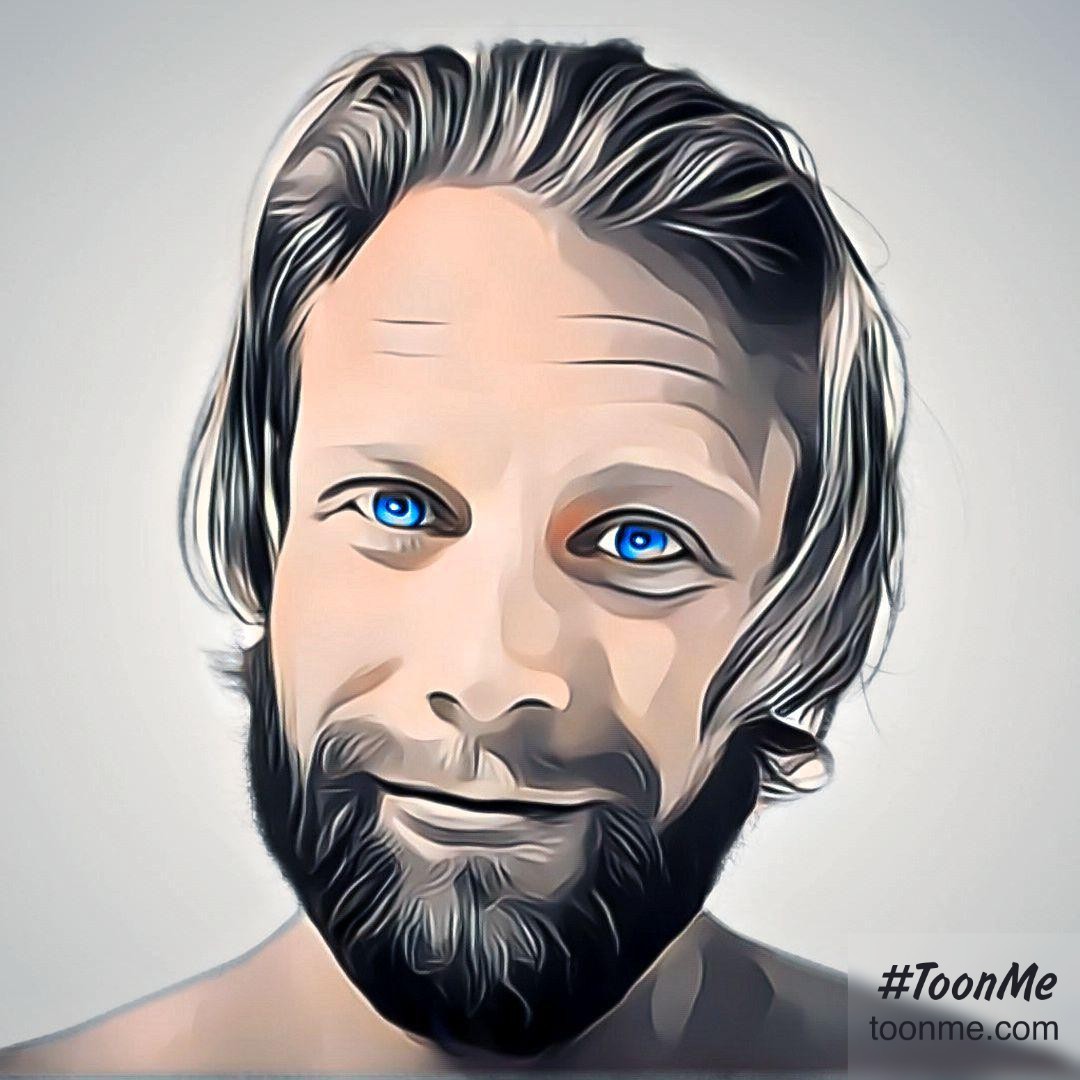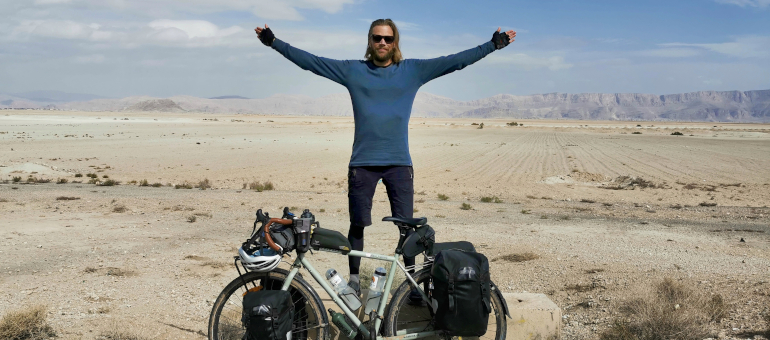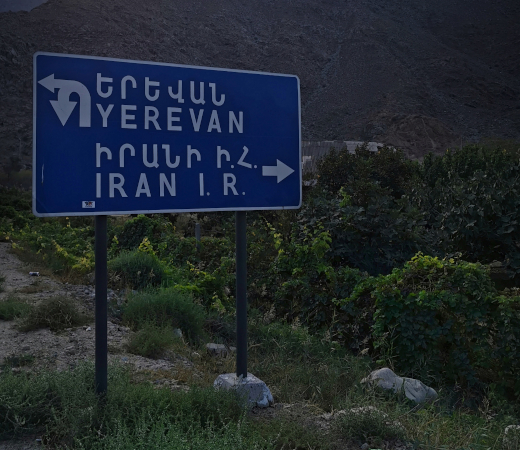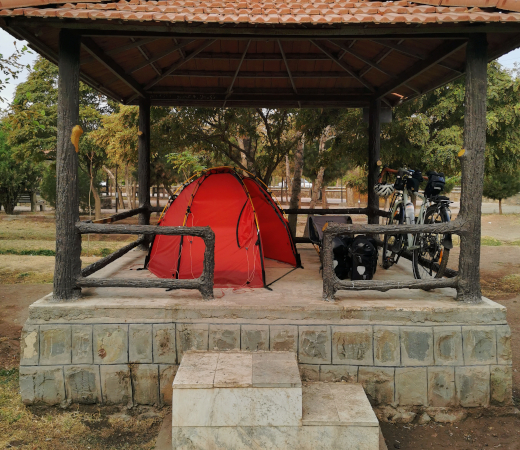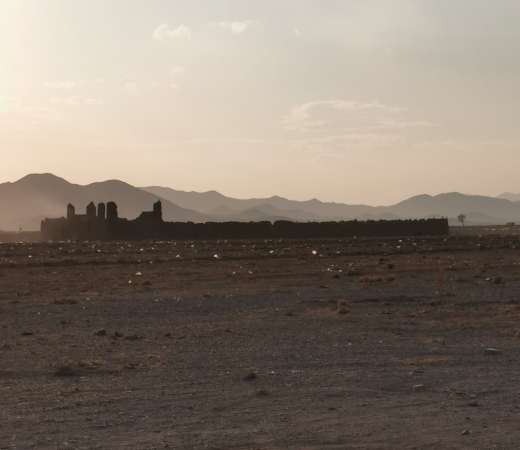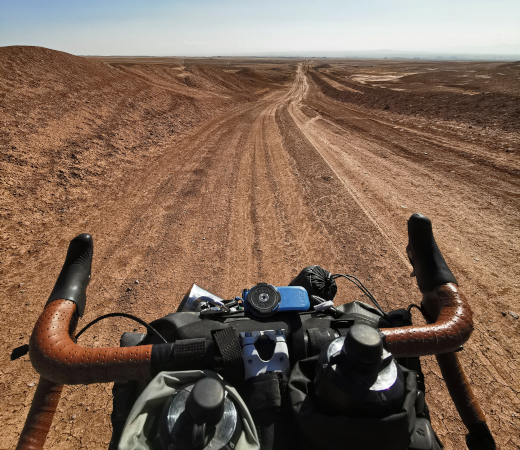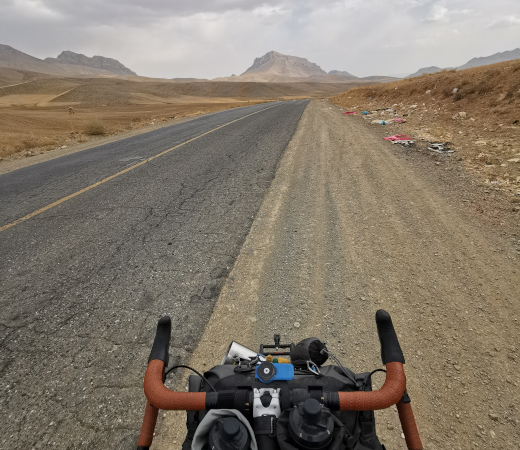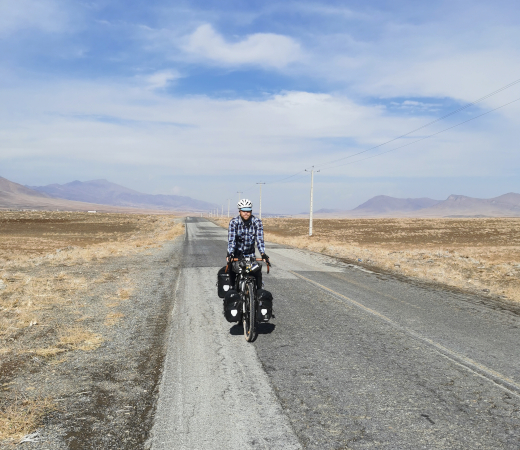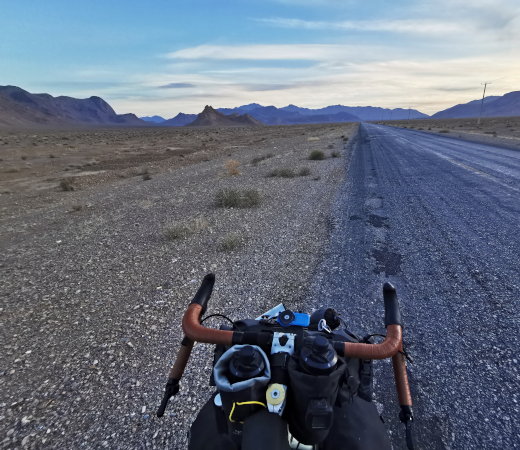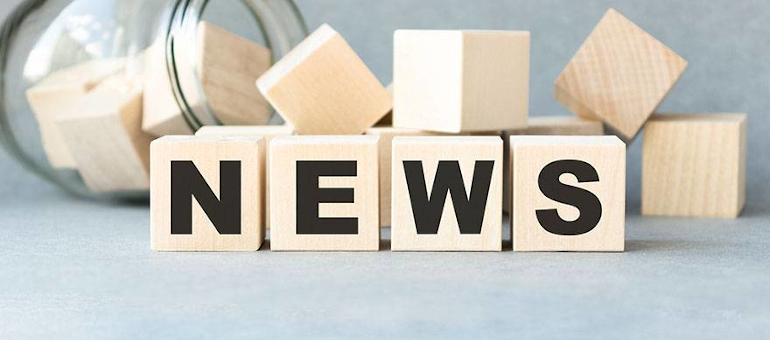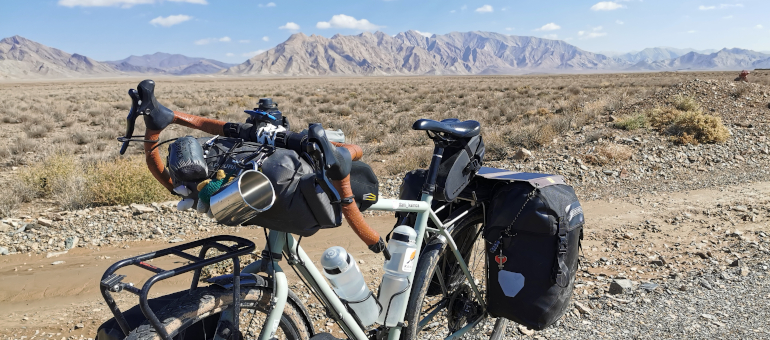Contents [hide]
Intro
In this bike touring blog for Iran, I am covering a big country and many miles of cycling. I’ve decided to split the blog post in two parts. In the first part, I’ll bring
you from the Armenian border town Meghri and into Iran where I biked through Tabriz and Hamedan. I ended up in Isfahan, well known for its Persian
architecture in its huge square with the 17th-century Shah Mosque.
Recap of week 70 to 73
After a bit of debating with myself whether to go or not, I decided to head for Iran on an early October morning. I biked along the border between the enclave
of Azerbaijan and Iran in stunning mountain scenery until I reached Jolfa where I got my first of many city park camping experiences. From here I turned my
bike and started to bike south. In Tabriz I did some quick admin tasks; I picked up my MAH card, exchanged money and got a SIM card. I met up with Andy
again who had left Meghri before me but decided to wait for me in Tabriz. Together we left the city on jam-packed and chaotic roads heading for Hamedan.
The scenery was mostly farmed lands with chilly nights. Winter was slowly approaching on this highly elevated plain. After a couple of weeks on the roads we
reached Isfahan, the old and historical capital of Persia. Isfahan was also the halfway mark on the route to the Persian Gulf.
To go, or not to go, that is the question
In my latest blog, it might have seemed that it was a quick and easy decision to enter Iran. But in all honesty, I was hanging out in Meghri for a week debating
whether to go or not. I’ve heard stories about western people being detained for little or no reason at all. The Iranian government is suspicious and wary of
people traveling independently in the country and I couldn’t shake off the stories about people being detained for months on charges that, for me at least, are
hard to understand. Coming from Europe I am used to a different set of rules and I would never intentionally do anything against Iranian law. It’s just hard to
figure out what not to do. I’ve heard about the french traveler who flew a drone close to a border and got sentenced to several years in prison. Just before
entering Iran, a Spanish traveler on his way to the World Cup got detained for visiting the grave of the woman who had ignited the wave of demonstrations that
was going on in the country. He was still detained when I left the country and I hope for his immediate release. All of this seems like trivial offenses to me but
they have serious consequences. The Iranian authorities were particularly sensitive to foreigners during these turbulent times and the government was accusing
the west of being the mastermind behind the unrest. In order not to take a wrong step while in Iran, I used the week in Meghri to do some mental preparation
and make up some rules for my travels in the country. Iran didn’t allow journalists to cover the protests so under no circumstances would I get close to one. I
would avoid bigger cities as much as possible and since the protests mainly happened during night, I would do my best to settle in or find accommodation
before it got too late and would not roam the streets too much at night either. I would not discuss the situation with locals. I would only take photos of empty
landscapes, small villages and tourist sights. With this toolbox of safety measures, I felt comfortable enough to travel through Iran. Also, I would team up with
Andy in Tabriz and the idea of having a travel buddy helped.
One early October morning I left Meghri in Armenia and headed towards the border as the sun was slowly rising up behind the mountains. The border crossing
was easy but time consuming. On the Armenian side of the border, they checked my passport very thoroughly and scanned my panniers. I was a bit confused
as I thought the country you left was not really interested in checking your passport nor going through your bags. But the Armenian border patrol was very
detailed in his work. For 15 minutes he looked at my passport. He scrutinized every page with a magnifying glass, scanned it with his phone and used an
ultraviolet light machine. This man was dedicated to his work I must say. Never have my passport been checked that good. At a point I was actually worried
that he would not accept my passport but of course it was all good in the end. I proceeded to get my panniers scanned on the Armenian side of the border just
to repeat the process on the Iranian side. The border was not busy with people at all which was to my luck because I could have been in a seriously long queue
if a lot of people had decided to cross the border at the same time as me. After an hour I was through and managed to find a guy just to exchange my Armenian
Dram to Iranian Rials. I was happy to have some Iranian currency in my pocket because my international credit cards do not work in this country due to
sanctions.
The confusing money system
The exchange guy was an honest man which was good for me because the Iranian money system is a confusing one. First of all, the currency rate which you
can look up on Google is not correct at all. It is the official one which banks use to make their transactions. Due to sanctions I assume, there is a parallel and
free market on the street where your foregin currency is worth a lot more. The official rate gives you 42.400 Iraian Rials for 1 USD. On the street you will get
362.300 Rials for 1 USD. That’s over eight times as much. This is the first thing to be aware of. You realize now that changing just a little bit of money will give
you a bag of local Iranian currency. They are all paper bills with the smallest being 20.000 Rials. You practically become an instant millionaire and you will need
an extra bag for the big wad of bills you are carrying around. I remember standing there at the border trying to count all the 100.000 and 500.000 bills I just had
received. I gave up halfway each time and after a couple of tries I gave up altogether to the great amusement of the exchange guy. We both laughed at this as
he recognized my struggles. I decided to trust the guy and stuffed my pockets full of money and left the border.
My first stop was the city of Jolfa, a stunningly beautiful day’s ride along steep and rugged blackish mountains that resembled volcanic rocks with its sharp
edges. Perhaps it was due to the recent flare up in the conflict between Armenia and Azerbaijan that caused long stretches of the road to be lined up with
heavy military vehicles and uniformed soldiers carrying their rifles. Distant sounds of flying helicopters were constantly filling the air above and around me.
Frequent watchtowers with guards were watching the border perimeter with the enclave of Azerbaijan just a few hundred meters away to my right at times. It
looked like they were preparing for a full-on war. At least the military personnel were friendly. They waved, said hello and wanted to know that I was most
welcome. Nice to know.
All the convenient public water taps that I’ve grown accustomed to in Turkey, Georgia and Armenia were not to be found anymore. So I had to buy water bottles
at the first store I could find in Jolfa. And now the money system got a lot more confusing. I learned that besides Rials, they have something called Toman.
A Toman is a superunit of the Rial. Toman means a ‘unit of ten thousand’ and therefore a Toman is quite literally worth 10.000 Rials. However, in 1932 one
Toman was decided to be equal to 10 Rial for some reason. Following the hyperinflation in 2019 the Iranian Central Bank changed this and made one Toman
equal to 10.000 Rials and would do a phase in period of two years. To make it easier to communicate prices, Iranians have accustomed themselves to state
the price in Toman but most use the old price of one Toman equal 10 Rials. So you now have to add a zero to get the price in Rials so you can find the correct
bills to pay with. Newly issued bills use the new one Toman equals 10.000 Rials conversation so that a 500.000 Rial bill will also have the number 50 written on
it. To make matters worse, some locals were giving prices with this new conversion. I never knew if they gave the price in Rials or in new or old Toman. Of
course I was very confused. For the first many days, I just opened my hands with money in it and let the locals take the money they needed. Iranians are very
honest people so this was never an issue for me. I felt like a little kiddo who hadn’t learned to count in big numbers yet. But after a while, I always asked if they
could state the price in Rials for me to avoid any Toman confusion.
In the end I managed to pay for the water. The man selling me the water was happy. I was happy. All was good. Darkness approached early, a little after five in
the afternoon, so it was high time to find a place to sleep for the night. From several others I’ve heard that camping in parks in Iran is perfectly acceptable so I
headed for the nearest park and pitched my tent under a pavilion.
City park camping
The idea of camping in the middle of the city with people walking around my tent was a bit weird at first. I had gotten used to hiding my camp spots away from
the public as much as possible. Now I was smack in the middle of people hanging out in the park. I entered the city park of Jolfa and stood a bit hesitant as a
man approached me. It was the city park janitor or manager. He must have read my mind because he instantly led me to the nearest pavilion and motioned for
me to sleep there.
Iranian city parks are nice. They have these covered pavilions with a concrete floor. So you never sleep tilted with an awkward angle. They have running water
so you can wash your pots and pans and dishes. Best of all, they have toilets which you can use. Some of them are more clean than others but they are all so
convenient to have nearby. You can take care of all your business stuff before heading onto the road. Being a city park, you always have some sort of store
nearby selling veggies, pasta, canned beans. No more carrying heavy food to your campspot. My all time favorite was lentils and veggies mixed with a canned
eggplant dish. Cheap, nutritious and tasty. What’s not to like? Some parks even have a guard present to make sure order is kept. I always looked around first to
see if I could spot a city park guard to ask for permission. Better to ask first even though I think they would never say no.
I was such a big fan of city parks that I stopped looking for wild camp spots. My daily routes would stop in a city and almost all cities of a certain size had a park.
Parks were marked in my navigation app so I usually just put that as my destination and started biking. Knowing where to sleep for the night made it alot easier
to just push your days all the way to sunset. You didn’t have to set aside time to look for a wild camp spot. Of course, you give up the nature scenic spots and
sometimes it becomes very noisy. Regardless, I was a fan.
My experience with an Iranian hospital
The following days to Tabriz were a bit disappointing after the spectacular scenery on my first day to Jolfa. Busy roads and uneventful nature. In Tabriz I met up
with Andy again, who would keep me company down to Bandar Abbas, and sorted out some practical stuff. I got my MAH card which is a prepaid tourist debit
card. This way you can take your big pile of cash and deposit it into a bank account and load your card with funds. You can use the MAH card practically
everywhere. It also serves as a backup if you should run out of cash. Due to sanctions your Visa and MasterCard are not working. So if you do not bring enough
cash into the country it can be a bit troublesome. Somehow the MAH card people offer you to transfer funds to the card via bank transfer and this way you have
a source of funds if you should need it. It’s a bit pricey to do the transfer but it's a good backup. I also sorted out a local SIM card and exchanged some USD
for Rials. I was all set to hit the road.
I didn’t linger much around Tabriz. During the one day I stayed there, I saw a lot of armed police and military and I heard rumors of ongoing protests during the
night. So I stayed inside at my hostel and left the following day. I had given up the idea of taking a route through the scenic Kurdistan region in the west. This
area was a hotspot for the protesters and the authorities were cracking down hard. Tehran was also off the route for the same reasons. So little choice was left
and I ended up taking a route going in the middle of the country passing Zanjan and Hamedan. It was just a lot of farmland. I mean a lot of farmland. For days
on end I saw nothing else. Winter was coming so all the crops had been harvested and I was left with a dull brownish earth to look at. The view would probably
have been better if I could have looked at beautifully colored crops swaying gently in the wind. It was also cold and rainy so my days just consisted of eating,
biking and sleeping.
To top it off I had started to get some problems with my ear. I’ll save you the gross details but I had some build up in the earlobe after a big diamond earring I
used to wear as a young wannabe cool hip hop kiddo. Long story short, I had to visit the hospital. This actually turned out to be one of my big experience
highlights on my way to Isfahan so I just have to share it with you.
It all happened on my first day after Tabriz. I had reached Bostanabad. The swelling was quite bad and I couldn’t sleep with my head on that side. Andy did not
feel well and when he said he wanted a rest day I took the opportunity to see if I could get my little problem fixed. This is the sort of thing you want to happen
back home where you know the system and how to go about it. Here, my best strategy was to look at Google Maps and search for a health care clinic which I
found conveniently located in the center of town.
I went early in the morning hoping for the best. Along with me I had a short translated sentence on my phone that said something in line with: I got a problem
with my ear and I want to see a doctor. Do you know the feeling of time freezing where everybody stops doing what they are doing to focus absolutely all of
their attention in order to grasp the meaning of this extraterrestrial being that just entered their perimeter? Well, that’s kind of what happened when I stepped
into the entrance hall of the health care clinic. I took one step inside and noticed a fully packed waiting room where every single head turned in my direction.
Silence. Dead silence. The only thing I managed to say was a vague ‘doctor’. After the initial surprise people started realizing I had not taken a wrong door, that
I was actually in the right place, that I was looking for a doctor. They ushered me to the nurse aka receptionist. I showed her my phone with the translated
sentence. She took a look at my ear and then held up one finger. Guess that meant I needed to wait for one hour. So I took a seat. I actually waited exactly one
hour. The doctor arrived and everybody in the room waved me up and in front of the line. I tried to object, telling them I was definitely not the first one to go, but
they would have it no other way. Now, the doctor was an efficient man of few words. I sat down in the chair, showed him my ear and he said three words:
surgery, hospital, emergency. Then he wrote something on a piece of paper for me to bring along. I left the doctor’s office.
Once back on the street I opened Google Maps to figure out where the hospital was and started walking. I did not get far because a man who was waiting in line
from the health care clinic had picked up his car and he was now driving alongside me. With a smiling face he said hospital and waved me into the car. That’s
how I found my way to the hospital.
Doctor’s note in hand, I entered the emergency unit at the hospital and went to the first employee dressed in a white uniform. We didn’t even need to speak a
single word because he immediately took my hand and barged into an office where a family was having a consultation with a doctor. He apparently wanted to
refer me to an English speaking person which was this young doctor lady. It felt very awkward. Waiting in line is a sacred thing for a Dane so I naturally tried to
tell I would wait outside for my turn but both the family and the doctor lady said it was no problem at all. The doctor lady left her office, took me straight to the
operating room, then took hold of the surgeon and asked if he was able to fix my ear. The English speaking surgeon said that he had an open slot in an hour
where he would do another patient as well. Doctor lady then took me to the administration office and left me there. At the administration office they punched in
my passport details, my local phone number and took my fingerprint for some reason. In the meantime the doctor lady had fetched a nurse that picked me up
from the administration office and took me to a dressing room where I had to crawl into one of these open-back blue operation gowns and a hairnet. Once I had
dressed up, I was taken to another nurse who put a drop in my arm. Ok, now I have to say that I started to get a bit nervous and asked what the drop was for.
They said it was only a standard setup for every patient going to the operating room. Hmmmm, ok I replied, and made it clear I was happy as long as they
wouldn’t cut my ear off. Next up the operating room. Around me I had the surgeon and four assisting nurses. It took five minutes for the surgeon to remove the
bad build-up stuff and when he was done I wanted to walk out but they said no no no. They rolled me onto a bed with wheels and wheeled me into the recovery
room where another nurse monitored me for the next half hour while giving me a liquid mixture of some sort via my drop (so that’s what they needed the drop
for). When they had made sure I was A-OK they said I could go to the dressing room to change clothes. Back in my civilian clothes a nurse took me down to
the administration office where I could pay. I expected this to be very expensive since they had given me VIP treatment all day long and for a short moment I
thought they had rushed me through with an express operation so they could earn some big money. But I ended up paying a bit less than 15 EUR. Hard to
believe and I had to ask twice if they were absolutely sure about the price.
All in all, I was super relieved to have my ear problem fixed. At the beginning of the day, walking into the health care clinic, I had not in my wildest imagination
expected this to work out so well. I don’t even speak the language. This level of kindness and help is something I haven’t experienced before and I have the
utmost respect for their professional behavior and efficiency. I actually had the same problem ten years ago in Denmark. Back then it took two months of
frustrating bureaucracy before I was appointed to a specialist who didn’t even fix it completely. It took the health care system in Bostanabad half a day all in all
with a far better result. My first week in Iran had not been particularly eventful but my hospital visit will always be a shining star of experiences on this first part of
my Iranian tour down to Isfahan.
The first sleepover with a local host
Cycling from Bostanabad towards Tehran is a stretch you just want to be over with but a necessary road to take if you want to avoid the Kurdistan region. You
obviously have a lot of traffic going to the bustling capital of Iran and there is also the atmosphere of the life of suburbs and urban industry. Cities here are not
very interesting and we quickly passed Zanjan and headed towards Hamedan. This area must definitely be the breadbasket of Iran. In every direction you look
there are vast plains of farmland which means you have some troubles finding a spot for your tent.
One day we had looked for a longer period after a suitable camp spot. There were no city parks nearby. Only farmland with no farmers to ask. It was getting
dark as we slowly rolled into this tiny village with a few square brickhouses spread evenly around on both sides of the road. I ventured into the nearest kiosk to
ask for a place to pitch our tents. All I hoped for was a garden to sleep in but I was referred to the parking lot nearby. Not what I was going for but it was a place
to sleep for the night. As we were setting up camp, a few locals came to say hello and then very quickly we got invited in for tea and were shown to the guest
room where we could sleep for the night. What an upgrade. We started out drinking tea and I think someone must have sent word out to the entire village,
because as we were sitting there one after the other came into the guesthouse to say hello. Some family, some friends and some just very random people. All
very friendly and eager to talk. This is the time when you are really happy you have the Google Translate app. It just brings so much more content to such an
evening. After answering all sorts of questions, mainly covering why I’m not married, they arranged food for us in their main house.
What I first noticed entering the main house of my host was the lack of furniture. This house has a really big living room. No sofa. No dinner table. No chairs.
Just carpets. You sit on the floor. You eat on the floor. You sleep on the floor. Everyone gathered around a dinner cloth which is spread out onto the floor and
with dishes of food to share. It’s such a feeling of togetherness and community. After dinner we would sit along the wall and talk some more. The entire family
gathered in this common area. This would never happen back home. In my family’s house, we would eat and then go to our separate rooms. Iranians are
sociable beings with a great sense of family values. They are also very hospitable. This would not be the last time I stayed with a local family. It happened
almost every day that you get invited to stay in someone’s home. But if you want to make some progress on the milage you have to decline some of them
otherwise you would not travel very far.
All the hellos, waves and welcomes you can ever want
As I cycled towards and past Hamedan there was one more thing that I quickly realized was a very Irianian thing to do. Literally every minute a passing vehicle
would honk and frantically wave. I would see smiling faces from oncoming truck drivers and waving hands through rear windows. People on motorcycles would
yell welcome and everytime I stopped to take a break, the locals would come and say hello. I’ve felt great hospitality in Albania and in Turkey. But Iranians take it
to another level. Never have I felt so welcome and never have I waved so much to people.
This made riding the boring roads down to Isfahan a true pleasure. It was not amazing nature scenery that did it for me on this stretch. It was the tender
enthusiasm you felt in every encounter with Iranians. The people of Iran quickly got a very special place in my heart and never have I fallen so quickly in love
with the people of a country as happened here. That was an unexpected highlight.
Reaching the halfway mark in Isfahan
I entered Iran with expectations of spectacular nature. Before coming here I had the idea of Iran being one big desert with scorching heat. On the contrary, I
had been biking for a couple of weeks in high altitudes along big plains of farmland. I entered Iran in mid October and soon snow would come. This part of Iran
would see more snow than what I see in Denmark which came as a big surprise. So much for hot deserts.
I had this in mind as I approached Isfahan on a long hectic entryway. Much good can be said about Iranians but they don’t really respect road rules that much. I
kept my focus on high alert as I was darting and dodging my way through densely trafficked roads with motorcycles and cars from time to time driving against
the traffic. A couple of tense hours later, men and Andy, had found our way to the center of the third largest city in Iran. It was high time to rest up for a few days
and do some sightseeing. Isfahan is known for its Naqsh-e Jahan Square which is one of the largest city squares in the world.
On my day around Isfahan I visited the kilometer long bazaars that would surround the big squares in town. I stood mesmerized and gazed upon the mosaic
tiles and calligraphic inscriptions that decorates the Shah Mosque which is one of the masterpieces of old Persian architecture.
Iran is such a big country. It’s hard to cover all the highlights on a bike. At least I managed to visit this old capital of Persia. A really good addition to my
experience list. After this I was ready to bike onwards towards Bandar Abbas. People promised me more true desert landscape and with fingers crossed I had
my hopes up. More of that in part 2.
announcement of a new travel volume
2022-10-15 | news
Announcement of a new travel volume. My next countries will be Iran, Pakistan and India. Main planned touring highlights are the desert landscapes of Iran, the
Karakoram Highway in Pakistan and the Kashmir region in India.
biketouring iran part 2
2022-11-26 | blog
The second part of my bike touring blog for Iran. From Isfahan to Bandar Abbas. From sand dunes in vast desert landscapes, under starry skies and rising
blood moons to gas station camping and a sudden change in the weather as I arrived on the hu...
